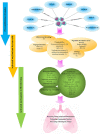Boosting therapeutic efficacy of mesenchymal stem cells in pulmonary fibrosis: The role of genetic modification and preconditioning strategies
- PMID: 37605719
- PMCID: PMC10440137
- DOI: 10.22038/IJBMS.2023.69023.15049
Boosting therapeutic efficacy of mesenchymal stem cells in pulmonary fibrosis: The role of genetic modification and preconditioning strategies
Abstract
Pulmonary fibrosis (PF) is the end stage of severe lung diseases, in which the lung parenchyma is replaced by fibrous scar tissue. The result is a remarkable reduction in pulmonary compliance, which may lead to respiratory failure and even death. Idiopathic pulmonary fibrosis (IPF) is the most prevalent form of PF, with no reasonable etiology. However, some factors are believed to be behind the etiology of PF, including prolonged administration of several medications (e.g., bleomycin and amiodarone), environmental contaminant exposure (e.g., gases, asbestos, and silica), and certain systemic diseases (e.g., systemic lupus erythematosus). Despite significant developments in the diagnostic approach to PF in the last few years, efforts to find more effective treatments remain challenging. With their immunomodulatory, anti-inflammatory, and anti-fibrotic properties, stem cells may provide a promising approach for treating a broad spectrum of fibrotic conditions. However, they may lose their biological functions after long-term in vitro culture or exposure to harsh in vivo situations. To overcome these limitations, numerous modification techniques, such as genetic modification, preconditioning, and optimization of cultivation methods for stem cell therapy, have been adopted. Herein, we summarize the previous investigations that have been designed to assess the effects of stem cell preconditioning or genetic modification on the regenerative capacity of stem cells in PF.
Keywords: Genetic modification; Preconditioning; Pulmonary fibrosis; Regenerative capacity; Stem cells.
Conflict of interest statement
The authors declare no conflicts of interest.
Figures
References
-
- Wuyts WA, Agostini C, Antoniou KM, Bouros D, Chambers R, et al. The pathogenesis of pulmonary fibrosis: a moving target. Eur Respir J. 2013;41:1207–1218. - PubMed
-
- Xu J, Li L, Xiong J, Zheng Y, Ye Q, Li Y. Cyclophosphamide combined with bone marrow mesenchymal stromal cells protects against bleomycin-induced lung fibrosis in mice. Ann Clin Lab Sci. 2015;45:292–300. - PubMed
Publication types
LinkOut - more resources
Full Text Sources

